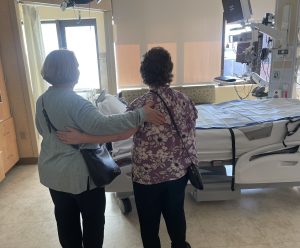Allergic reaction takes her breath away, requires lifesaving ECMO intervention

June 22, 2023, is a day Jodie Straub does not remember, but one her sister, Dawn Thompson, will never forget.

Jodie visits the ECMO team almost a year after her hospitalization.
“The doctor called me to say that Jodie’s situation was looking very grave,” Dawn explained. “She had taken a turn for the worse, and she was struggling with the ventilator. They were having a hard time improving her blood pressure. The doctor said that HCMC had an ECMO machine that could help and that we should transfer her. Of course I agreed.”
Dawn was a meticulous note-taker during Jodie’s life-threatening illness last year, even as she faced her own health concerns.
How it all started
An allergic reaction to a medication resulted in Jodie – a nurse and mom of two children from Shoreview – to be taken by ambulance to a burn center on June 16. The allergic reaction was compromising her breathing, causing an inflammatory process that was making the lining of her airways peel off from the inside. The reaction affected other areas of her body as well, with the final diagnosis being Stevens Johnson Syndrome (SJS) with toxic epidermal necrolysis syndrome (TENS). A potentially life-threatening combination.
The following morning, during a conversation with her sister to explain what was happening and give more directions about specific help needed for her kids, she was interrupted by her nurse because her condition was quickly deteriorating.

ECMO Program Coordinator Beth Heather, RN shows Jodie an ECMO machine and answers her questions.
“I just need 15 more minutes,” Jodie told the nurse. But the nurse advised, “you don’t have 15 more minutes.”
Recalling that conversation, Dawn tearfully explained how she did not know at the time it would be the last time she would hear her sister’s voice for a month.
“We both didn’t realize how serious this was,” said Dawn, who had a mastectomy just one week prior and could not visit her sister. Her doctor advised that she had to heal and remain healthy before starting radiation.
“I was supposed to be supporting my sister during this time, and now she had to look after me and my kids while she was going through her own health issues,” Jodie lamented.
ECMO at HCMC
After a week in an induced coma at another hospital, Dawn received that frightening phone call about Jodie’s deteriorating condition. She was immediately transferred to HCMC for extracorporeal membranous oxygenation, otherwise known as ECMO.
“Jodie was very sick when she arrived in our Medical Intensive Care Unit,” explains Dr. Matt Prekker, the medical director of ECMO. “She was started on ECMO at the referring hospital, in part because it was not safe to transport her to our hospital using the ventilator alone. It was unable to support her any longer.”

Jodie and her sister, Dawn, see Jodie’s room in the Medical Intensive Care Unit at HCMC where she received ECMO treatment.
After evaluation by the pulmonary and critical care physicians at HCMC, it was clear that Jodie needed more ECMO support than one ECMO machine could provide. This was due to her healthy heart function but very sick lungs – they were functioning at 0% capacity because of the SJS/TENS. The ECMO team placed two more large catheters in Jodie’s body to allow support with two ECMO circuits at the same time, a rarely performed but lifesaving strategy. She improved over time, and one ECMO circuit and pair of catheters were removed 12 days later. Seven days after that, the remaining ECMO catheters and circuit were removed as her lungs were able to do their job again.
“I couldn’t go there to see her, and I was so scared, so it was helpful that everyone at HCMC was super kind and communicative with me,” recalls Dawn. “In fact, on many occasions, they reached out to me before I called. The team was always positive. And she was treated so well. They were so supportive.”
Jodie is also grateful for her ECMO team, even though she does not remember them: “I would have died without ECMO. Thank you, ECMO team – this makes me emotional – thank you for taking good care of me. They acted so quickly. I wish I could give each one of them a hug. Thank you from the bottom of my heart.”

Dawn and Jodie with the ECMO team.

